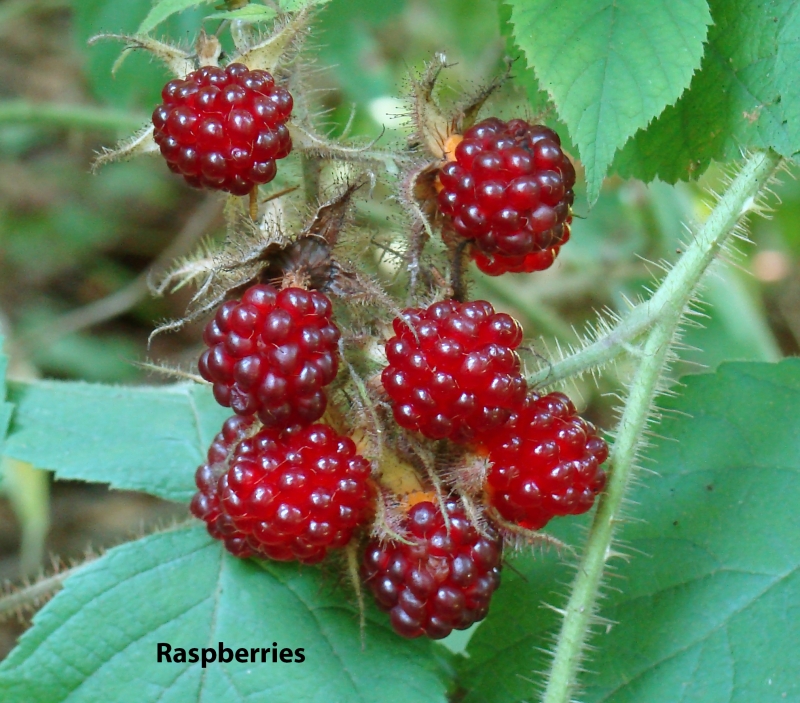
Brambleberries: What's the Difference?
It's about that time of year to begin harvesting fruits for jams and desserts. From July through September, bramble bushes across the North Country will be loaded with red raspberries, black raspberries and blackberries. You may have no trouble recognzing these berries as edible, but can you tell the difference?

Raspberries and blackberries go by many names, such as brambles, black caps, brambleberries, thimbleberries, and more. I've been popping these berries in my mouth ever since my grandparents taught me they were edible. However, just as the intertwining vines and thorny stems make for tricky picking, our names for these common and delicious berries have gotten tangled up.
All varieties of blackberries and raspberries fall under the category of flowering Roses in the family Rosaceae. The taxonomy of these berries can get confusing because of hybridization and selective breeding designed to produce new varieties of cultivated berries. One such example is the boysenberry, which is a hybrid berry formed from a cross between a raspberry, blackberry and loganberry. For now, we will focus on recognizing three common wild berries you'll find growing in the North Country: red raspberries (Rubus strigosus), black raspberries (Rubus occidentalis) and blackberries (Rubus fruticosus).

There are a couple of umbrella terms you may have heard that tend to be used as common names for each of these. First is brambleberry. The term bramble refers to any tangled vine or arching shrub that has a thorny appearance. Second is thimbleberry. This name comes from the shape of the fruit having a thimble-like appearance, so you can see why each of these berries might fit that term. This is easily confused with "true" thimbleberries (Rubus parviflorus), which grow in the Western half of North America with some populations thriving in the Great Lakes regions.
So what do you need to look for in order to tell the difference? Since bramble bushes don't flower or produce fruit until at least the second year of growth, it can be hard to tell what kind of berry the thorny canes will produce. When they do flower, all three will produce a 5-petaled white rose, so the best way to differentiate is by observing a mature plant throughout the seasons and noting differences in the branch and berry formation. Here are a few key identifying features for each type of berry:
- Red raspberries - One of the most obvious differentiating features between a raspberry and a blackberry is the hollow center of a ripe raspberry. This is because a raspberry will separate from the receptacle where the flower originally grew, while in blackberries, it remains intact when picked. The stems of red raspberry plants tend to be rounded with whitish dust and bristly thorns. Raspberries are also shorter than blackberries, only growing up to 6 feet in height.
- Black raspberries (also referred to as "black caps") - They too have a hollow center when picked, yet ripe black caps tend to be more firm than red raspberries to help them tolerate the cold better. Their hardiness also contributes to their ripening before other brambleberries. The berry is much darker in color than raspberries with very fine white hairs. The stems are also different than red raspberries in that they have strong hooked prickles rather than bristly thorns.
- Blackberries - A blackberry will have a small white stem inside when picked and won't be hollow because the receptacle remains attached. The thorny stems lack whitish powder and are more ridged and angular. Blackberries have stout prickles and will grow much taller, sometimes up to 10 feet high. Finally, the leaflets of blackberry plants are green on the underside, whereas red and black raspberry leaves are white beneath.

So why would you want to know the difference between these berries if all of them are edible?
- They ripen at different times. Raspberries are usually the earliest to ripen from June through August, while blackberries tend to ripen later, from July through September.
- They each provide different nutritional benefits. Black raspberries have some of the highest levels of antioxidants (disease prevention agents) among fruits. The leaves and stems of blackberry plants can be used to treat inflammation or sore throats. Additionally, raspberries have high levels of vitamin C and other anti-cancer compounds.
- They have different tastes. Blackberries are a little more tart, black caps are a little firmer and red raspberries are a little sweeter. This leads us into the final point about the uses of each berry.
- They have different uses and applications. The tartness of blackberries makes them an excellent addition to desserts, including pies, ice cream and any other sugary treat. The same holds true for raspberries, however their natural sweetness makes them great for eating out of hand, or as an addition to breakfast smoothies, oatmeal topping and jams.



What an informative blogpost! Thank you, the images and descriptions are excellent.